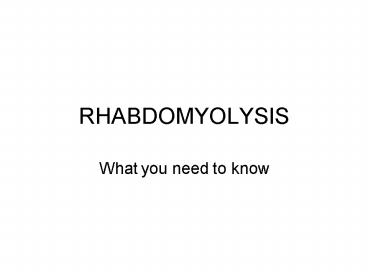RHABDOMYOLYSIS - PowerPoint PPT Presentation
1 / 10
Title: RHABDOMYOLYSIS
1
RHABDOMYOLYSIS
- What you need to know
2
- Rhabdomyolysis is a common disorder which
may result from a large variety of diseases,
trauma, or toxic insults to skeletal muscle. It
may be defined as a clinical and biochemical
syndrome resulting from an injury which damages
the integrity of the sarcolemma of skeletal
muscle, leading to the release of potentially
toxic muscle cell components into the
circulationThis may result in potential
life-threatening complications including
myoglobinuric acute renal failure, hyperkalaemia
and cardiac arrest, disseminated intravascular
coagulation, and more locally, compartment
syndrome. - -http//members.tripod.com/baggas/rhabdo.html
3
- We can dispose with much medical detail with a
quick and easy description of rhabdomyolysis as a
potentially lethal systemic meltdown initiated by
the kidneys in response to the presence of shed
muscle-fiber debris and exhaust in the
bloodstream. - Crossfit Journal 2005, Issue 38
4
What Happens
- Muscle cells are damaged
- Releases muscle fiber content into the
bloodstream - Potassium and myoglobin is released into
bloodstream, calcium and sodium build up in the
muscle cells - Myoglobin breaks down into ferrihemate in the
kidneys - Kidney damage occurs, can cause acute renal
failure (and death) - Potassium can cause alterations in heart function
- High enough levels can cause arrythmia and heart
failure (and death)
5
History
- Five cases recorded with this type of workout
- All athletes were previously involved in
low-intensity, low power output workouts - All athletes were fit (ex SWAT member, Special
Forces member) - All athletes made a complete recovery
- All continue to do this kind of workout (without
another occurrence of rhabdo).
6
Drug Reactions
- Toxic-mediated rhabdomyolysis may result from
prescription and nonprescription medications,
including the following - Mevacore (lovastatin)
- Antihistamines
- Salicylates
- Caffeine
- Fibric acid derivatives (eg, bezafibrate,
clofibrate, fenofibrate, gemfibrozil) - Neuroleptics
- Anesthetic and paralytic agents (the malignant
hyperthermia syndrome) - Amphotericin B
- Quinine
- Corticosteroids
- Atorvastatin
- Fluvastatin
- Lovastatin
- Pitavastatin (marketed in Japan, South Korea,
India) - Pravastatin
- Rosuvastatin
- Simvastatin
- Cerivastatin (recalled from US market)
7
Substance Abuse
- Toxin-mediated rhabdomyolysis may result from
substance abuse, including abuse of the
following - Ethanol
- Methanol
- Ethylene glycol
- Isopropanol
- Heroin
- Methadone
- Barbiturates
- Cocaine
- Amphetamine
- Phencyclidine
- 3,4-methylenedioxymethamphetamine (MDMA, ecstasy)
- Lysergic acid diethylamide (LSD)
8
Symptoms
- Brown Urine
- NOT yellow, go IMMEDIATELY to the hospital!
- Muscle weakness
- Extreme soreness that lasts more than two/three
days
9
Prevention
- Hydrate with water beforehand
- At least four hours prior start drinking water
- Stop all caffeine intake
- Hydrate during and after the exercise
- Monitor body signs throughout workout
- Dont work out or compete if you have a cold/flu
- Rhabdo is EASY to prevent
10
Bibliography
- Crossfit Journal 2005, Issue 38
- http//www.crossfit.com/cf-journal/rhabdo.pdf
- Rhabdomyolysis
- http//members.tripod.com/baggas/rhabdo.html
- eMedicine Rhabdomyolysis
- http//www.emedicine.com/emerg/topic508.htm































